ACC303 Assignment: Integrated Reporting Framework Essay Analysis
VerifiedAdded on 2022/08/25
|11
|2781
|27
Essay
AI Summary
This essay examines the Integrated Reporting (IR) Framework, a significant initiative for corporate reporting. It explores the framework's principles, importance, and the need for its adoption, particularly in the context of sustainability and transparency. The essay highlights the benefits of IR, such as building trust with stakeholders and improving internal management. It discusses the use of IR in both public and private sectors, emphasizing its role in connecting financial and non-financial performance. The essay also delves into the six capitals (financial, manufactured, intellectual, human, social and relationship, and natural) recognized by the IIRC framework and their implications. Furthermore, it addresses the challenges to the widespread adoption of IR, such as investor unfamiliarity, and recommends strategies to overcome these hurdles. A case study of KPMG's annual report illustrates the practical application of the IR framework, including the identification and management of various capitals, and the importance of transparency. Overall, the essay underscores the importance of IR in providing a comprehensive view of a company's performance and its long-term value creation, especially for stakeholders.
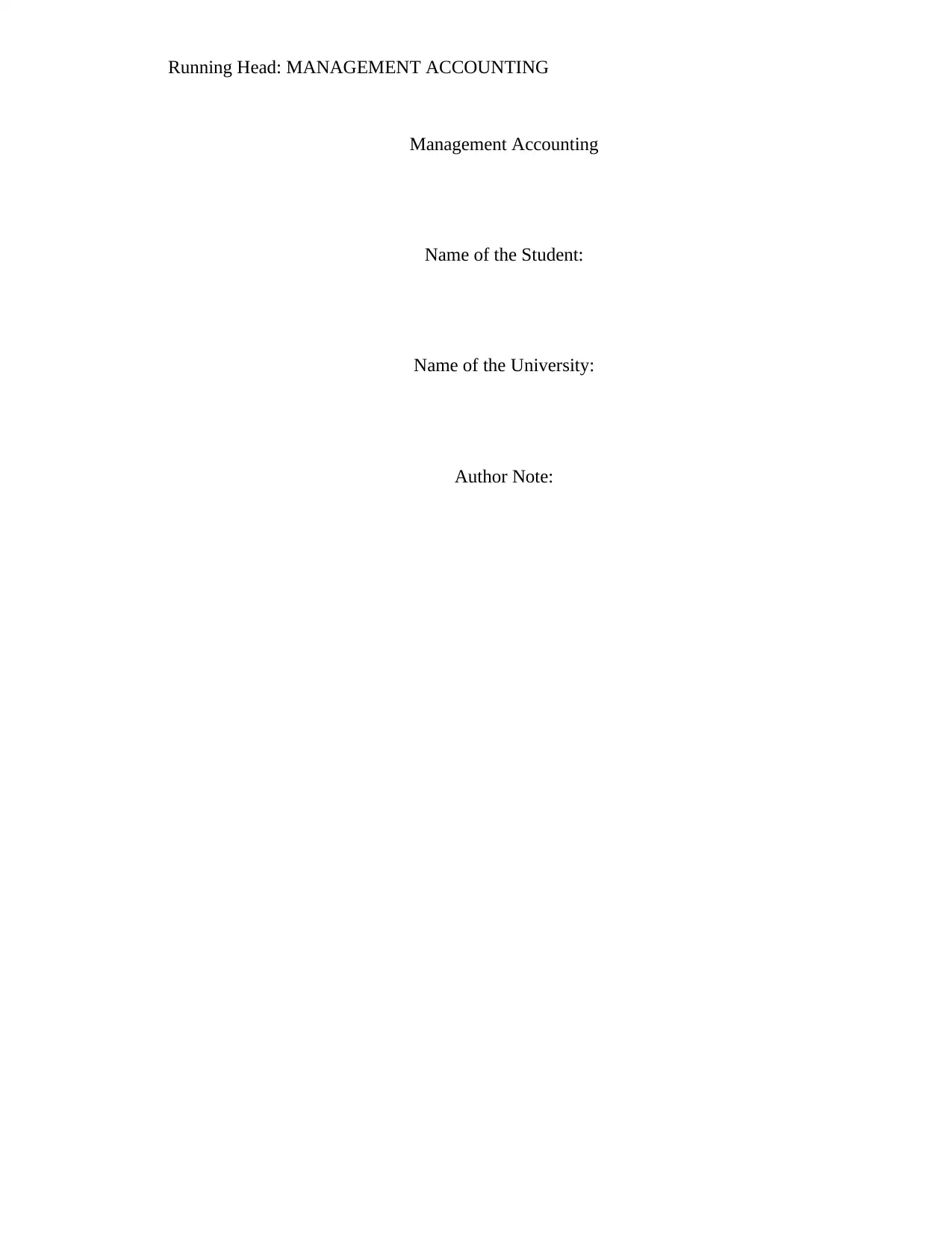
Running Head: MANAGEMENT ACCOUNTING
Management Accounting
Name of the Student:
Name of the University:
Author Note:
Management Accounting
Name of the Student:
Name of the University:
Author Note:
Paraphrase This Document
Need a fresh take? Get an instant paraphrase of this document with our AI Paraphraser
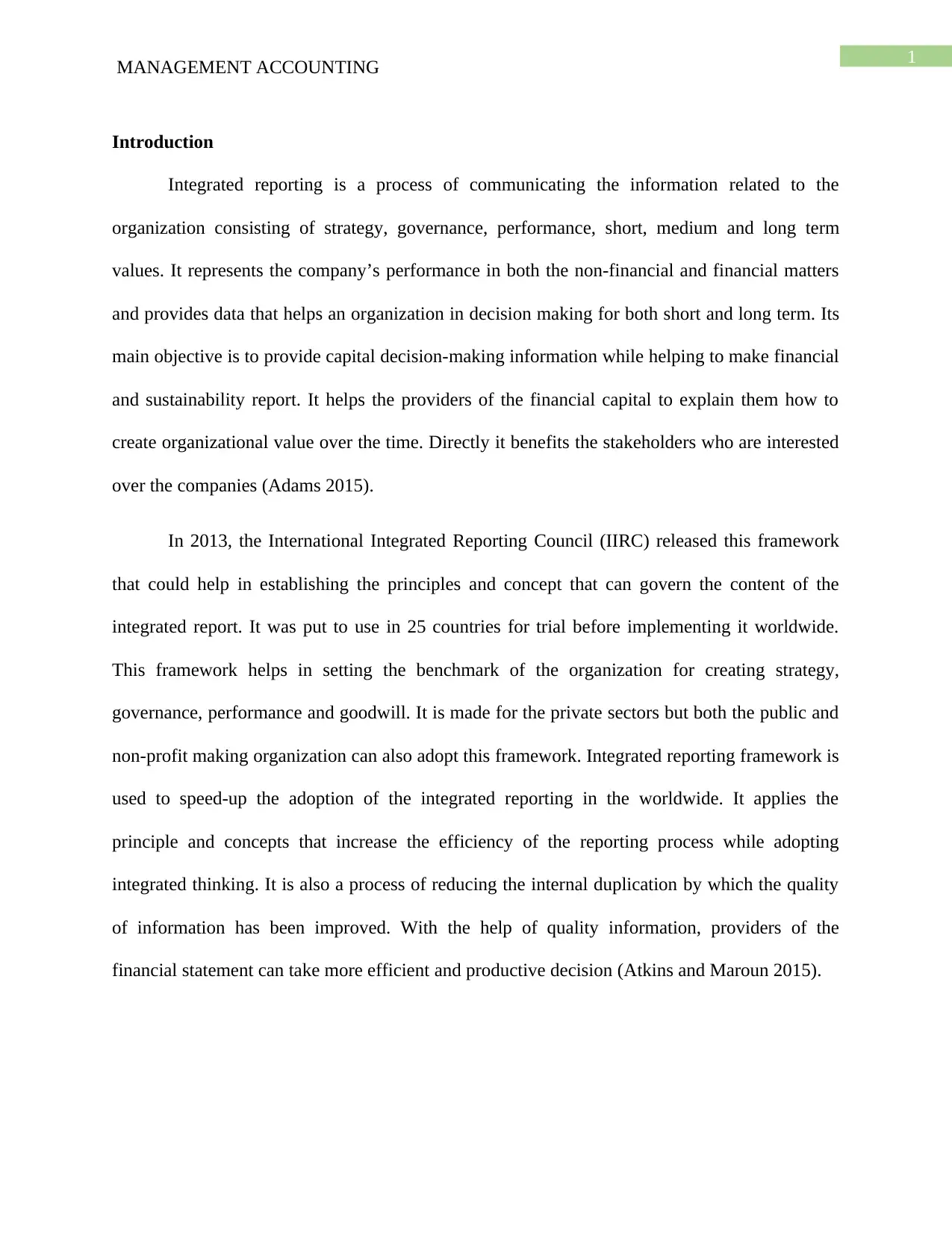
1
MANAGEMENT ACCOUNTING
Introduction
Integrated reporting is a process of communicating the information related to the
organization consisting of strategy, governance, performance, short, medium and long term
values. It represents the company’s performance in both the non-financial and financial matters
and provides data that helps an organization in decision making for both short and long term. Its
main objective is to provide capital decision-making information while helping to make financial
and sustainability report. It helps the providers of the financial capital to explain them how to
create organizational value over the time. Directly it benefits the stakeholders who are interested
over the companies (Adams 2015).
In 2013, the International Integrated Reporting Council (IIRC) released this framework
that could help in establishing the principles and concept that can govern the content of the
integrated report. It was put to use in 25 countries for trial before implementing it worldwide.
This framework helps in setting the benchmark of the organization for creating strategy,
governance, performance and goodwill. It is made for the private sectors but both the public and
non-profit making organization can also adopt this framework. Integrated reporting framework is
used to speed-up the adoption of the integrated reporting in the worldwide. It applies the
principle and concepts that increase the efficiency of the reporting process while adopting
integrated thinking. It is also a process of reducing the internal duplication by which the quality
of information has been improved. With the help of quality information, providers of the
financial statement can take more efficient and productive decision (Atkins and Maroun 2015).
MANAGEMENT ACCOUNTING
Introduction
Integrated reporting is a process of communicating the information related to the
organization consisting of strategy, governance, performance, short, medium and long term
values. It represents the company’s performance in both the non-financial and financial matters
and provides data that helps an organization in decision making for both short and long term. Its
main objective is to provide capital decision-making information while helping to make financial
and sustainability report. It helps the providers of the financial capital to explain them how to
create organizational value over the time. Directly it benefits the stakeholders who are interested
over the companies (Adams 2015).
In 2013, the International Integrated Reporting Council (IIRC) released this framework
that could help in establishing the principles and concept that can govern the content of the
integrated report. It was put to use in 25 countries for trial before implementing it worldwide.
This framework helps in setting the benchmark of the organization for creating strategy,
governance, performance and goodwill. It is made for the private sectors but both the public and
non-profit making organization can also adopt this framework. Integrated reporting framework is
used to speed-up the adoption of the integrated reporting in the worldwide. It applies the
principle and concepts that increase the efficiency of the reporting process while adopting
integrated thinking. It is also a process of reducing the internal duplication by which the quality
of information has been improved. With the help of quality information, providers of the
financial statement can take more efficient and productive decision (Atkins and Maroun 2015).
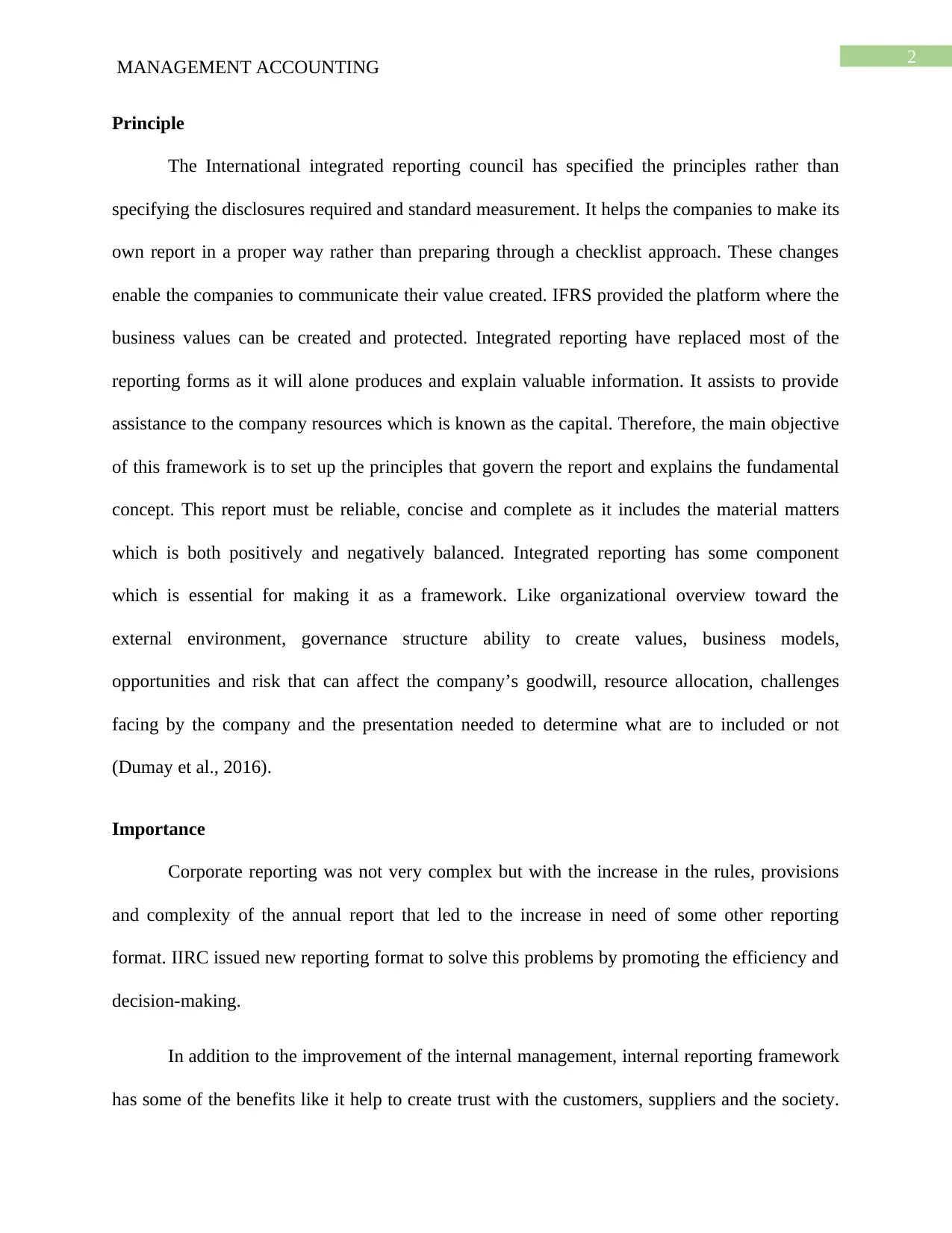
2
MANAGEMENT ACCOUNTING
Principle
The International integrated reporting council has specified the principles rather than
specifying the disclosures required and standard measurement. It helps the companies to make its
own report in a proper way rather than preparing through a checklist approach. These changes
enable the companies to communicate their value created. IFRS provided the platform where the
business values can be created and protected. Integrated reporting have replaced most of the
reporting forms as it will alone produces and explain valuable information. It assists to provide
assistance to the company resources which is known as the capital. Therefore, the main objective
of this framework is to set up the principles that govern the report and explains the fundamental
concept. This report must be reliable, concise and complete as it includes the material matters
which is both positively and negatively balanced. Integrated reporting has some component
which is essential for making it as a framework. Like organizational overview toward the
external environment, governance structure ability to create values, business models,
opportunities and risk that can affect the company’s goodwill, resource allocation, challenges
facing by the company and the presentation needed to determine what are to included or not
(Dumay et al., 2016).
Importance
Corporate reporting was not very complex but with the increase in the rules, provisions
and complexity of the annual report that led to the increase in need of some other reporting
format. IIRC issued new reporting format to solve this problems by promoting the efficiency and
decision-making.
In addition to the improvement of the internal management, internal reporting framework
has some of the benefits like it help to create trust with the customers, suppliers and the society.
MANAGEMENT ACCOUNTING
Principle
The International integrated reporting council has specified the principles rather than
specifying the disclosures required and standard measurement. It helps the companies to make its
own report in a proper way rather than preparing through a checklist approach. These changes
enable the companies to communicate their value created. IFRS provided the platform where the
business values can be created and protected. Integrated reporting have replaced most of the
reporting forms as it will alone produces and explain valuable information. It assists to provide
assistance to the company resources which is known as the capital. Therefore, the main objective
of this framework is to set up the principles that govern the report and explains the fundamental
concept. This report must be reliable, concise and complete as it includes the material matters
which is both positively and negatively balanced. Integrated reporting has some component
which is essential for making it as a framework. Like organizational overview toward the
external environment, governance structure ability to create values, business models,
opportunities and risk that can affect the company’s goodwill, resource allocation, challenges
facing by the company and the presentation needed to determine what are to included or not
(Dumay et al., 2016).
Importance
Corporate reporting was not very complex but with the increase in the rules, provisions
and complexity of the annual report that led to the increase in need of some other reporting
format. IIRC issued new reporting format to solve this problems by promoting the efficiency and
decision-making.
In addition to the improvement of the internal management, internal reporting framework
has some of the benefits like it help to create trust with the customers, suppliers and the society.
⊘ This is a preview!⊘
Do you want full access?
Subscribe today to unlock all pages.

Trusted by 1+ million students worldwide
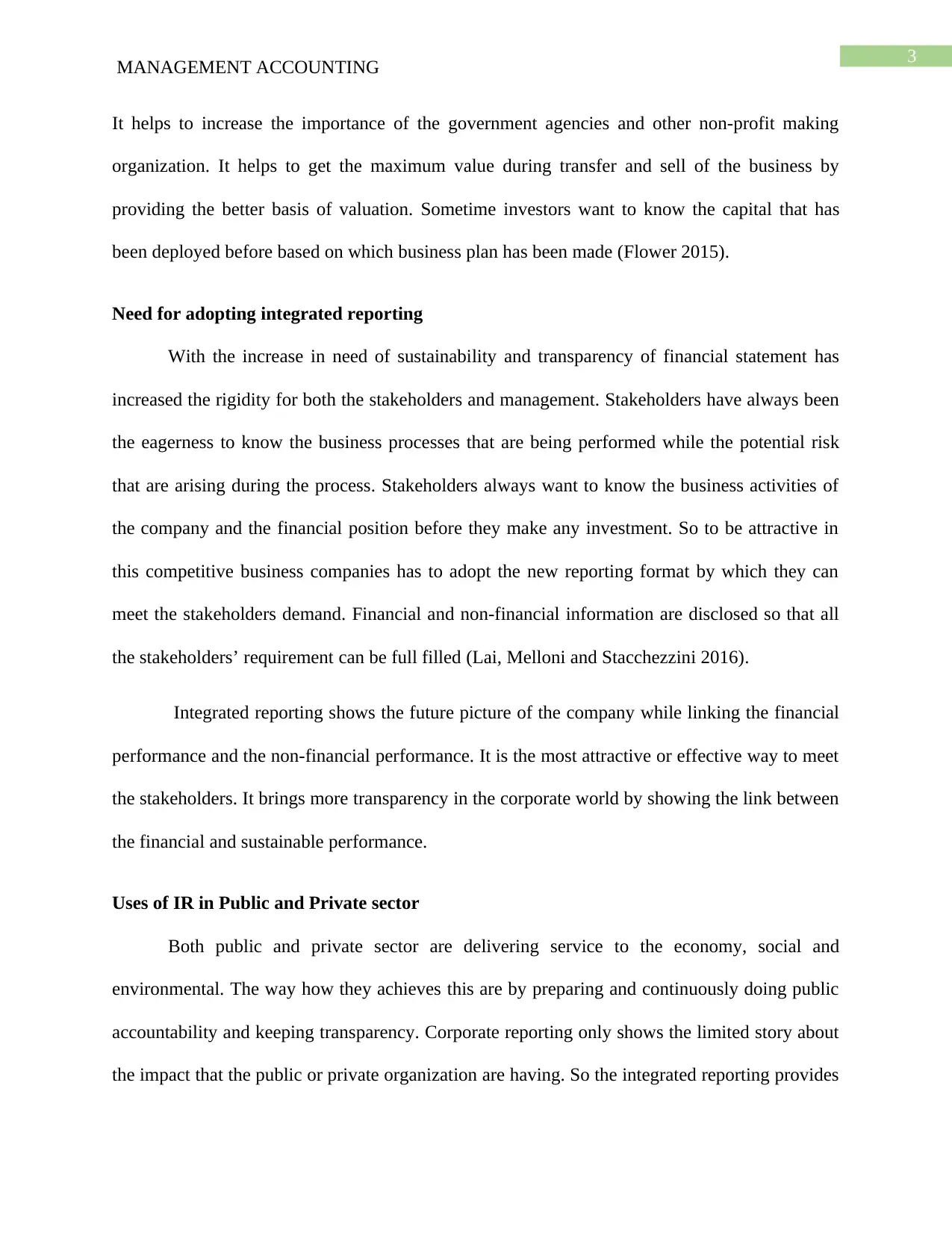
3
MANAGEMENT ACCOUNTING
It helps to increase the importance of the government agencies and other non-profit making
organization. It helps to get the maximum value during transfer and sell of the business by
providing the better basis of valuation. Sometime investors want to know the capital that has
been deployed before based on which business plan has been made (Flower 2015).
Need for adopting integrated reporting
With the increase in need of sustainability and transparency of financial statement has
increased the rigidity for both the stakeholders and management. Stakeholders have always been
the eagerness to know the business processes that are being performed while the potential risk
that are arising during the process. Stakeholders always want to know the business activities of
the company and the financial position before they make any investment. So to be attractive in
this competitive business companies has to adopt the new reporting format by which they can
meet the stakeholders demand. Financial and non-financial information are disclosed so that all
the stakeholders’ requirement can be full filled (Lai, Melloni and Stacchezzini 2016).
Integrated reporting shows the future picture of the company while linking the financial
performance and the non-financial performance. It is the most attractive or effective way to meet
the stakeholders. It brings more transparency in the corporate world by showing the link between
the financial and sustainable performance.
Uses of IR in Public and Private sector
Both public and private sector are delivering service to the economy, social and
environmental. The way how they achieves this are by preparing and continuously doing public
accountability and keeping transparency. Corporate reporting only shows the limited story about
the impact that the public or private organization are having. So the integrated reporting provides
MANAGEMENT ACCOUNTING
It helps to increase the importance of the government agencies and other non-profit making
organization. It helps to get the maximum value during transfer and sell of the business by
providing the better basis of valuation. Sometime investors want to know the capital that has
been deployed before based on which business plan has been made (Flower 2015).
Need for adopting integrated reporting
With the increase in need of sustainability and transparency of financial statement has
increased the rigidity for both the stakeholders and management. Stakeholders have always been
the eagerness to know the business processes that are being performed while the potential risk
that are arising during the process. Stakeholders always want to know the business activities of
the company and the financial position before they make any investment. So to be attractive in
this competitive business companies has to adopt the new reporting format by which they can
meet the stakeholders demand. Financial and non-financial information are disclosed so that all
the stakeholders’ requirement can be full filled (Lai, Melloni and Stacchezzini 2016).
Integrated reporting shows the future picture of the company while linking the financial
performance and the non-financial performance. It is the most attractive or effective way to meet
the stakeholders. It brings more transparency in the corporate world by showing the link between
the financial and sustainable performance.
Uses of IR in Public and Private sector
Both public and private sector are delivering service to the economy, social and
environmental. The way how they achieves this are by preparing and continuously doing public
accountability and keeping transparency. Corporate reporting only shows the limited story about
the impact that the public or private organization are having. So the integrated reporting provides
Paraphrase This Document
Need a fresh take? Get an instant paraphrase of this document with our AI Paraphraser
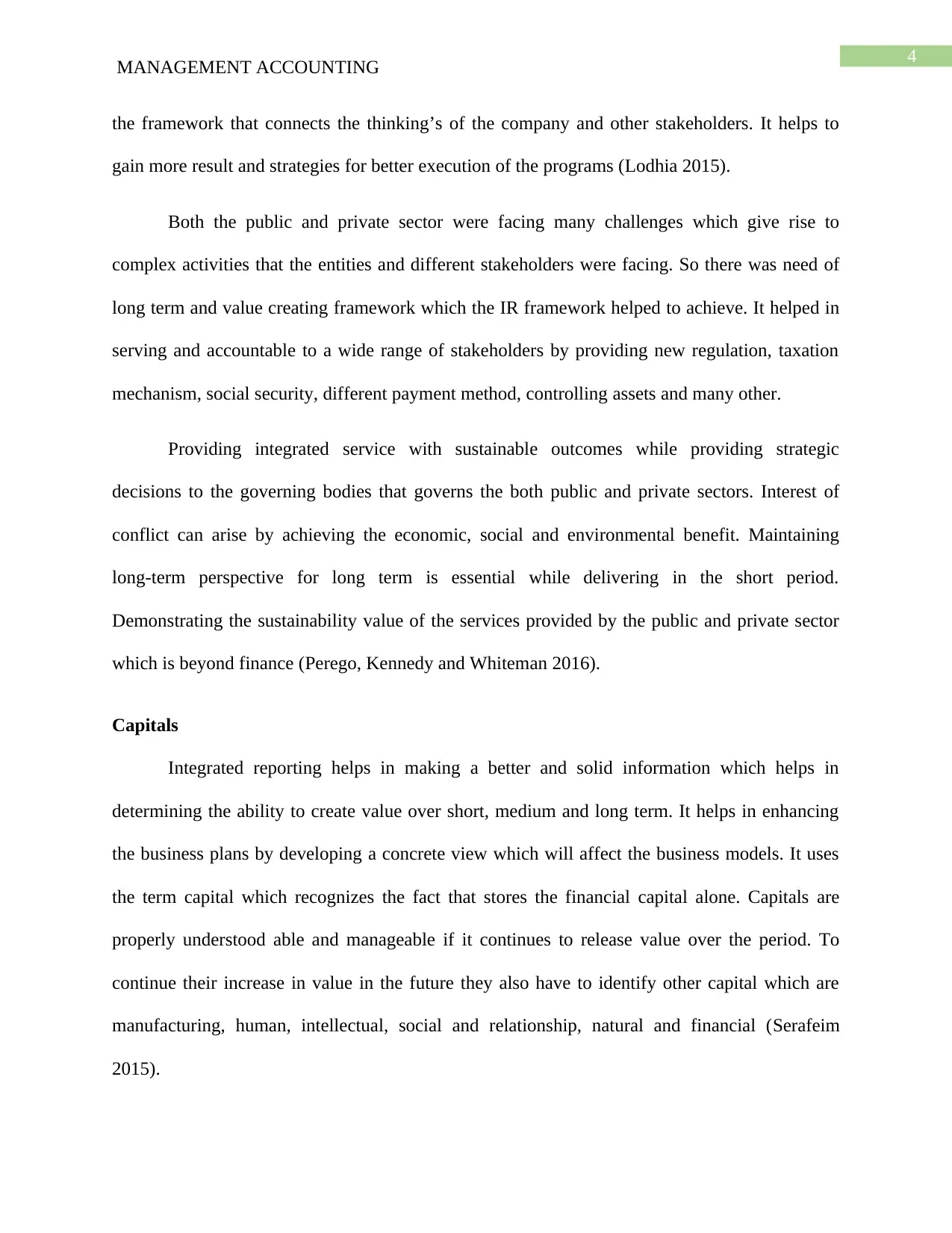
4
MANAGEMENT ACCOUNTING
the framework that connects the thinking’s of the company and other stakeholders. It helps to
gain more result and strategies for better execution of the programs (Lodhia 2015).
Both the public and private sector were facing many challenges which give rise to
complex activities that the entities and different stakeholders were facing. So there was need of
long term and value creating framework which the IR framework helped to achieve. It helped in
serving and accountable to a wide range of stakeholders by providing new regulation, taxation
mechanism, social security, different payment method, controlling assets and many other.
Providing integrated service with sustainable outcomes while providing strategic
decisions to the governing bodies that governs the both public and private sectors. Interest of
conflict can arise by achieving the economic, social and environmental benefit. Maintaining
long-term perspective for long term is essential while delivering in the short period.
Demonstrating the sustainability value of the services provided by the public and private sector
which is beyond finance (Perego, Kennedy and Whiteman 2016).
Capitals
Integrated reporting helps in making a better and solid information which helps in
determining the ability to create value over short, medium and long term. It helps in enhancing
the business plans by developing a concrete view which will affect the business models. It uses
the term capital which recognizes the fact that stores the financial capital alone. Capitals are
properly understood able and manageable if it continues to release value over the period. To
continue their increase in value in the future they also have to identify other capital which are
manufacturing, human, intellectual, social and relationship, natural and financial (Serafeim
2015).
MANAGEMENT ACCOUNTING
the framework that connects the thinking’s of the company and other stakeholders. It helps to
gain more result and strategies for better execution of the programs (Lodhia 2015).
Both the public and private sector were facing many challenges which give rise to
complex activities that the entities and different stakeholders were facing. So there was need of
long term and value creating framework which the IR framework helped to achieve. It helped in
serving and accountable to a wide range of stakeholders by providing new regulation, taxation
mechanism, social security, different payment method, controlling assets and many other.
Providing integrated service with sustainable outcomes while providing strategic
decisions to the governing bodies that governs the both public and private sectors. Interest of
conflict can arise by achieving the economic, social and environmental benefit. Maintaining
long-term perspective for long term is essential while delivering in the short period.
Demonstrating the sustainability value of the services provided by the public and private sector
which is beyond finance (Perego, Kennedy and Whiteman 2016).
Capitals
Integrated reporting helps in making a better and solid information which helps in
determining the ability to create value over short, medium and long term. It helps in enhancing
the business plans by developing a concrete view which will affect the business models. It uses
the term capital which recognizes the fact that stores the financial capital alone. Capitals are
properly understood able and manageable if it continues to release value over the period. To
continue their increase in value in the future they also have to identify other capital which are
manufacturing, human, intellectual, social and relationship, natural and financial (Serafeim
2015).
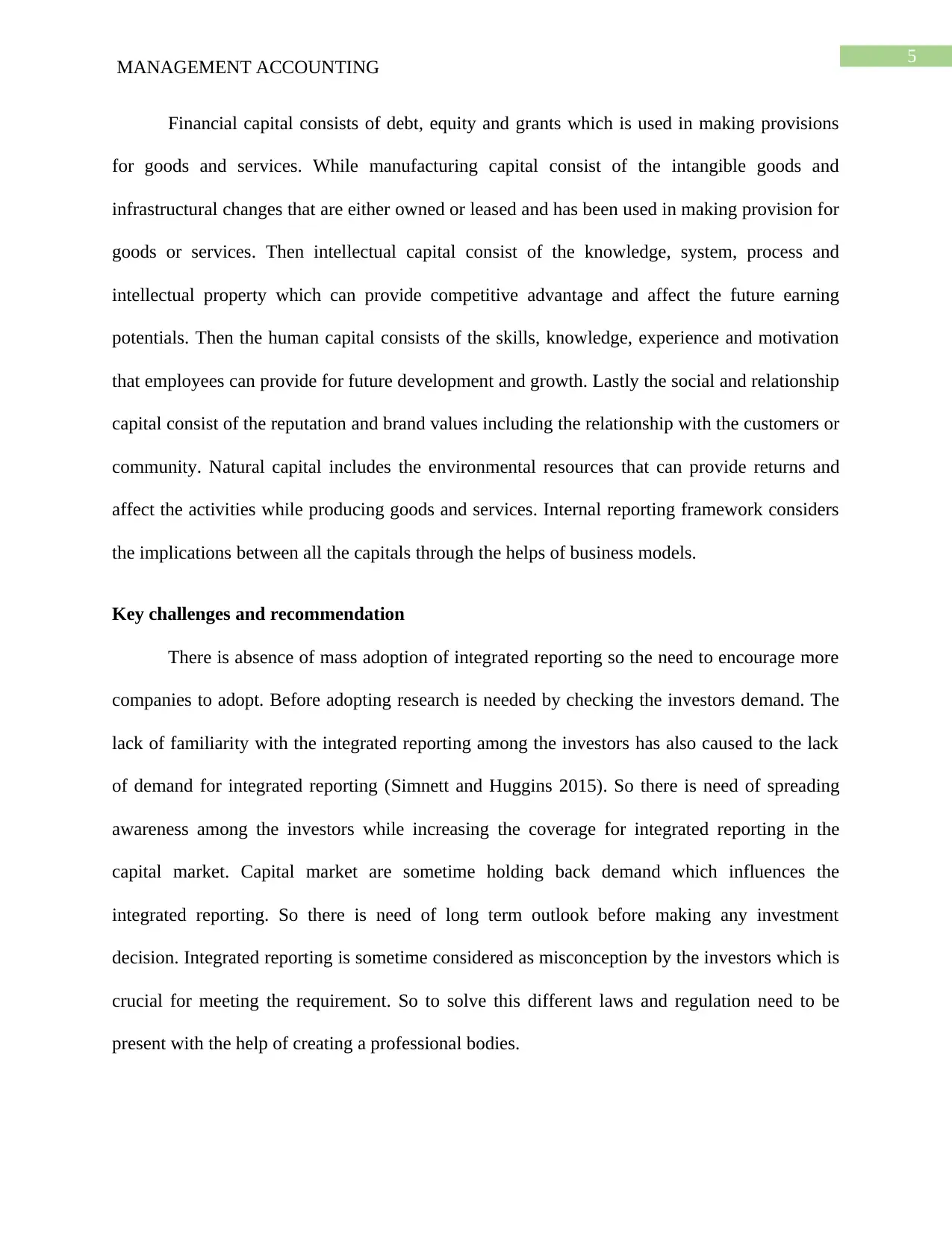
5
MANAGEMENT ACCOUNTING
Financial capital consists of debt, equity and grants which is used in making provisions
for goods and services. While manufacturing capital consist of the intangible goods and
infrastructural changes that are either owned or leased and has been used in making provision for
goods or services. Then intellectual capital consist of the knowledge, system, process and
intellectual property which can provide competitive advantage and affect the future earning
potentials. Then the human capital consists of the skills, knowledge, experience and motivation
that employees can provide for future development and growth. Lastly the social and relationship
capital consist of the reputation and brand values including the relationship with the customers or
community. Natural capital includes the environmental resources that can provide returns and
affect the activities while producing goods and services. Internal reporting framework considers
the implications between all the capitals through the helps of business models.
Key challenges and recommendation
There is absence of mass adoption of integrated reporting so the need to encourage more
companies to adopt. Before adopting research is needed by checking the investors demand. The
lack of familiarity with the integrated reporting among the investors has also caused to the lack
of demand for integrated reporting (Simnett and Huggins 2015). So there is need of spreading
awareness among the investors while increasing the coverage for integrated reporting in the
capital market. Capital market are sometime holding back demand which influences the
integrated reporting. So there is need of long term outlook before making any investment
decision. Integrated reporting is sometime considered as misconception by the investors which is
crucial for meeting the requirement. So to solve this different laws and regulation need to be
present with the help of creating a professional bodies.
MANAGEMENT ACCOUNTING
Financial capital consists of debt, equity and grants which is used in making provisions
for goods and services. While manufacturing capital consist of the intangible goods and
infrastructural changes that are either owned or leased and has been used in making provision for
goods or services. Then intellectual capital consist of the knowledge, system, process and
intellectual property which can provide competitive advantage and affect the future earning
potentials. Then the human capital consists of the skills, knowledge, experience and motivation
that employees can provide for future development and growth. Lastly the social and relationship
capital consist of the reputation and brand values including the relationship with the customers or
community. Natural capital includes the environmental resources that can provide returns and
affect the activities while producing goods and services. Internal reporting framework considers
the implications between all the capitals through the helps of business models.
Key challenges and recommendation
There is absence of mass adoption of integrated reporting so the need to encourage more
companies to adopt. Before adopting research is needed by checking the investors demand. The
lack of familiarity with the integrated reporting among the investors has also caused to the lack
of demand for integrated reporting (Simnett and Huggins 2015). So there is need of spreading
awareness among the investors while increasing the coverage for integrated reporting in the
capital market. Capital market are sometime holding back demand which influences the
integrated reporting. So there is need of long term outlook before making any investment
decision. Integrated reporting is sometime considered as misconception by the investors which is
crucial for meeting the requirement. So to solve this different laws and regulation need to be
present with the help of creating a professional bodies.
⊘ This is a preview!⊘
Do you want full access?
Subscribe today to unlock all pages.

Trusted by 1+ million students worldwide
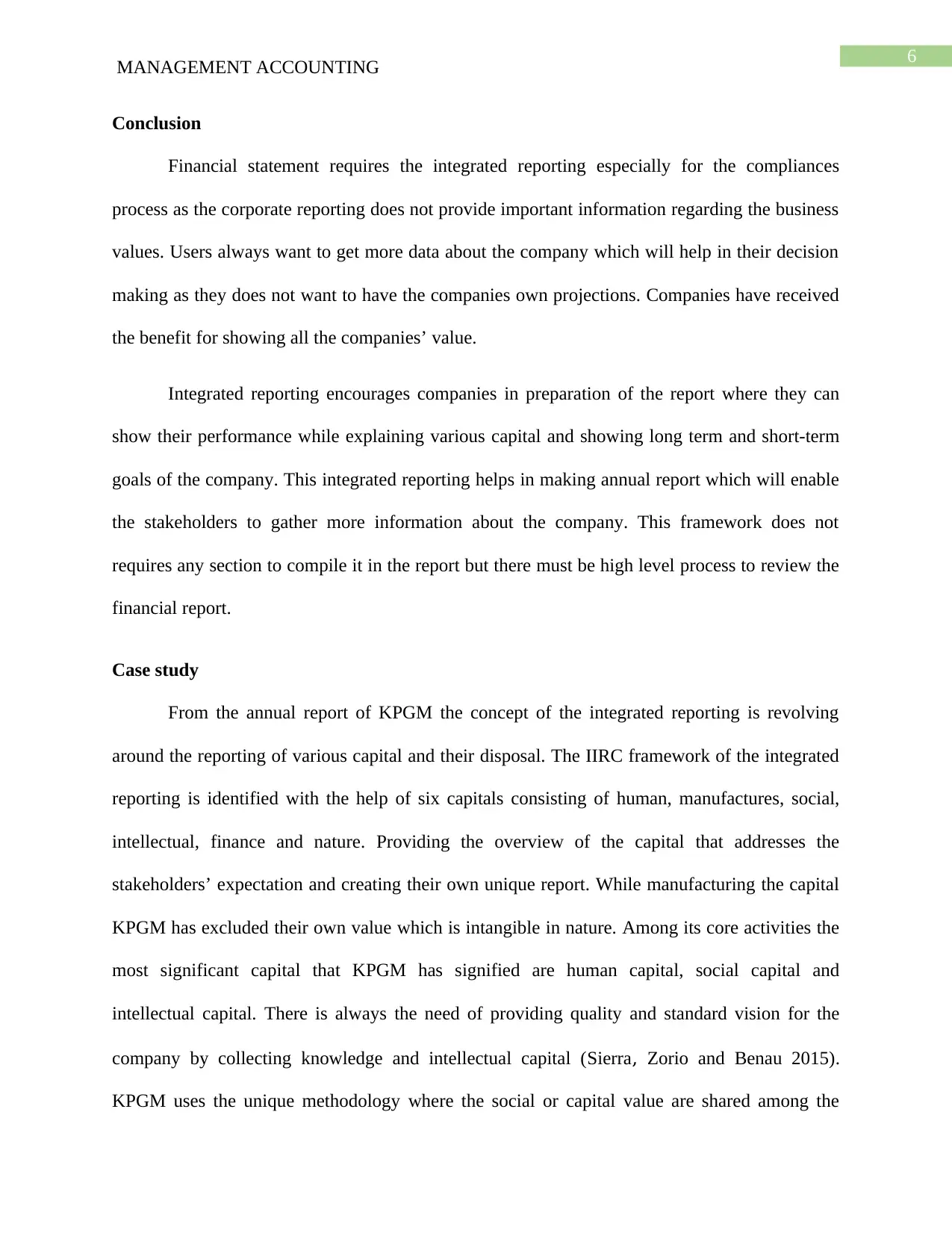
6
MANAGEMENT ACCOUNTING
Conclusion
Financial statement requires the integrated reporting especially for the compliances
process as the corporate reporting does not provide important information regarding the business
values. Users always want to get more data about the company which will help in their decision
making as they does not want to have the companies own projections. Companies have received
the benefit for showing all the companies’ value.
Integrated reporting encourages companies in preparation of the report where they can
show their performance while explaining various capital and showing long term and short-term
goals of the company. This integrated reporting helps in making annual report which will enable
the stakeholders to gather more information about the company. This framework does not
requires any section to compile it in the report but there must be high level process to review the
financial report.
Case study
From the annual report of KPGM the concept of the integrated reporting is revolving
around the reporting of various capital and their disposal. The IIRC framework of the integrated
reporting is identified with the help of six capitals consisting of human, manufactures, social,
intellectual, finance and nature. Providing the overview of the capital that addresses the
stakeholders’ expectation and creating their own unique report. While manufacturing the capital
KPGM has excluded their own value which is intangible in nature. Among its core activities the
most significant capital that KPGM has signified are human capital, social capital and
intellectual capital. There is always the need of providing quality and standard vision for the
company by collecting knowledge and intellectual capital (Sierra, Zorio and Benau 2015).
KPGM uses the unique methodology where the social or capital value are shared among the
MANAGEMENT ACCOUNTING
Conclusion
Financial statement requires the integrated reporting especially for the compliances
process as the corporate reporting does not provide important information regarding the business
values. Users always want to get more data about the company which will help in their decision
making as they does not want to have the companies own projections. Companies have received
the benefit for showing all the companies’ value.
Integrated reporting encourages companies in preparation of the report where they can
show their performance while explaining various capital and showing long term and short-term
goals of the company. This integrated reporting helps in making annual report which will enable
the stakeholders to gather more information about the company. This framework does not
requires any section to compile it in the report but there must be high level process to review the
financial report.
Case study
From the annual report of KPGM the concept of the integrated reporting is revolving
around the reporting of various capital and their disposal. The IIRC framework of the integrated
reporting is identified with the help of six capitals consisting of human, manufactures, social,
intellectual, finance and nature. Providing the overview of the capital that addresses the
stakeholders’ expectation and creating their own unique report. While manufacturing the capital
KPGM has excluded their own value which is intangible in nature. Among its core activities the
most significant capital that KPGM has signified are human capital, social capital and
intellectual capital. There is always the need of providing quality and standard vision for the
company by collecting knowledge and intellectual capital (Sierra, Zorio and Benau 2015).
KPGM uses the unique methodology where the social or capital value are shared among the
Paraphrase This Document
Need a fresh take? Get an instant paraphrase of this document with our AI Paraphraser
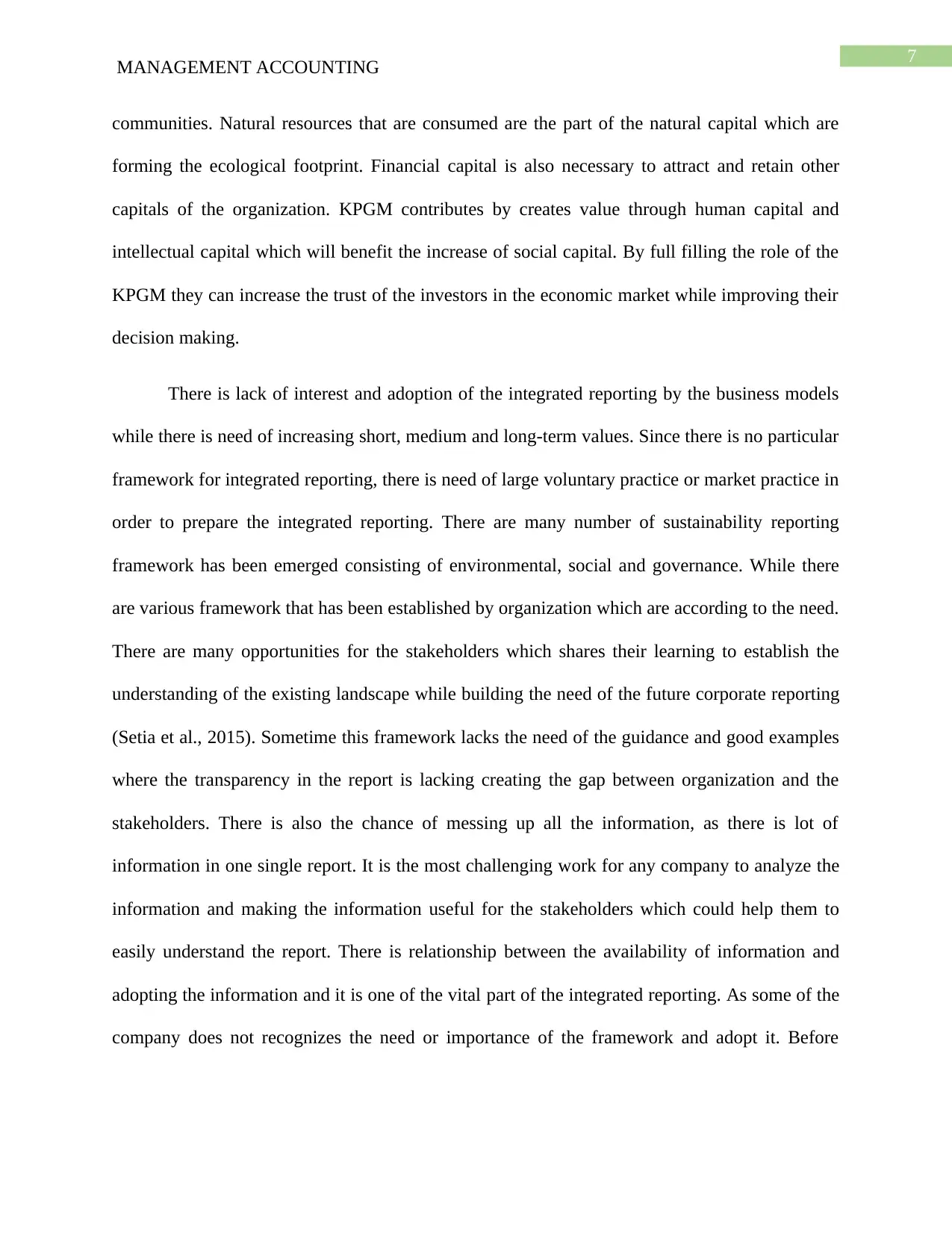
7
MANAGEMENT ACCOUNTING
communities. Natural resources that are consumed are the part of the natural capital which are
forming the ecological footprint. Financial capital is also necessary to attract and retain other
capitals of the organization. KPGM contributes by creates value through human capital and
intellectual capital which will benefit the increase of social capital. By full filling the role of the
KPGM they can increase the trust of the investors in the economic market while improving their
decision making.
There is lack of interest and adoption of the integrated reporting by the business models
while there is need of increasing short, medium and long-term values. Since there is no particular
framework for integrated reporting, there is need of large voluntary practice or market practice in
order to prepare the integrated reporting. There are many number of sustainability reporting
framework has been emerged consisting of environmental, social and governance. While there
are various framework that has been established by organization which are according to the need.
There are many opportunities for the stakeholders which shares their learning to establish the
understanding of the existing landscape while building the need of the future corporate reporting
(Setia et al., 2015). Sometime this framework lacks the need of the guidance and good examples
where the transparency in the report is lacking creating the gap between organization and the
stakeholders. There is also the chance of messing up all the information, as there is lot of
information in one single report. It is the most challenging work for any company to analyze the
information and making the information useful for the stakeholders which could help them to
easily understand the report. There is relationship between the availability of information and
adopting the information and it is one of the vital part of the integrated reporting. As some of the
company does not recognizes the need or importance of the framework and adopt it. Before
MANAGEMENT ACCOUNTING
communities. Natural resources that are consumed are the part of the natural capital which are
forming the ecological footprint. Financial capital is also necessary to attract and retain other
capitals of the organization. KPGM contributes by creates value through human capital and
intellectual capital which will benefit the increase of social capital. By full filling the role of the
KPGM they can increase the trust of the investors in the economic market while improving their
decision making.
There is lack of interest and adoption of the integrated reporting by the business models
while there is need of increasing short, medium and long-term values. Since there is no particular
framework for integrated reporting, there is need of large voluntary practice or market practice in
order to prepare the integrated reporting. There are many number of sustainability reporting
framework has been emerged consisting of environmental, social and governance. While there
are various framework that has been established by organization which are according to the need.
There are many opportunities for the stakeholders which shares their learning to establish the
understanding of the existing landscape while building the need of the future corporate reporting
(Setia et al., 2015). Sometime this framework lacks the need of the guidance and good examples
where the transparency in the report is lacking creating the gap between organization and the
stakeholders. There is also the chance of messing up all the information, as there is lot of
information in one single report. It is the most challenging work for any company to analyze the
information and making the information useful for the stakeholders which could help them to
easily understand the report. There is relationship between the availability of information and
adopting the information and it is one of the vital part of the integrated reporting. As some of the
company does not recognizes the need or importance of the framework and adopt it. Before
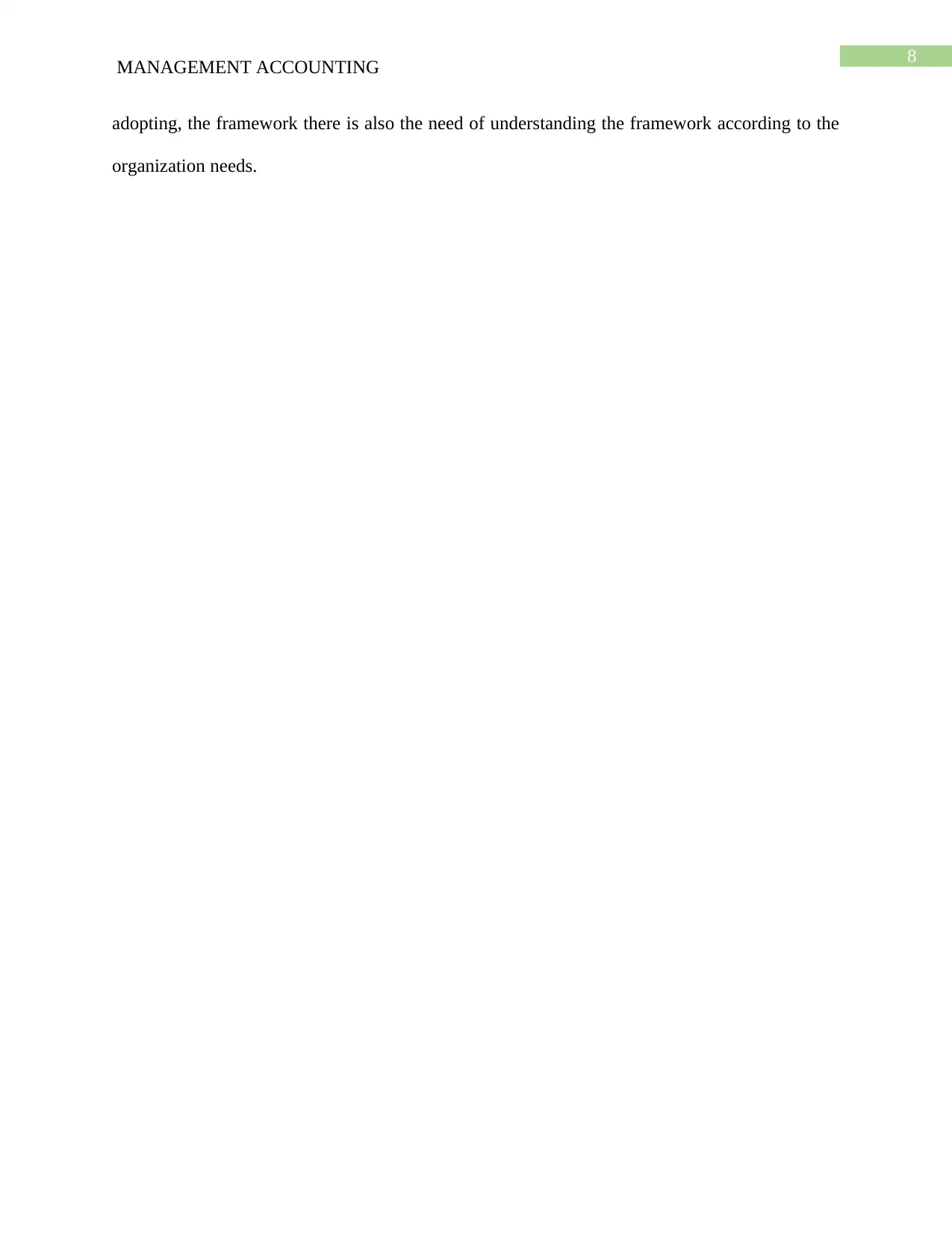
8
MANAGEMENT ACCOUNTING
adopting, the framework there is also the need of understanding the framework according to the
organization needs.
MANAGEMENT ACCOUNTING
adopting, the framework there is also the need of understanding the framework according to the
organization needs.
⊘ This is a preview!⊘
Do you want full access?
Subscribe today to unlock all pages.

Trusted by 1+ million students worldwide
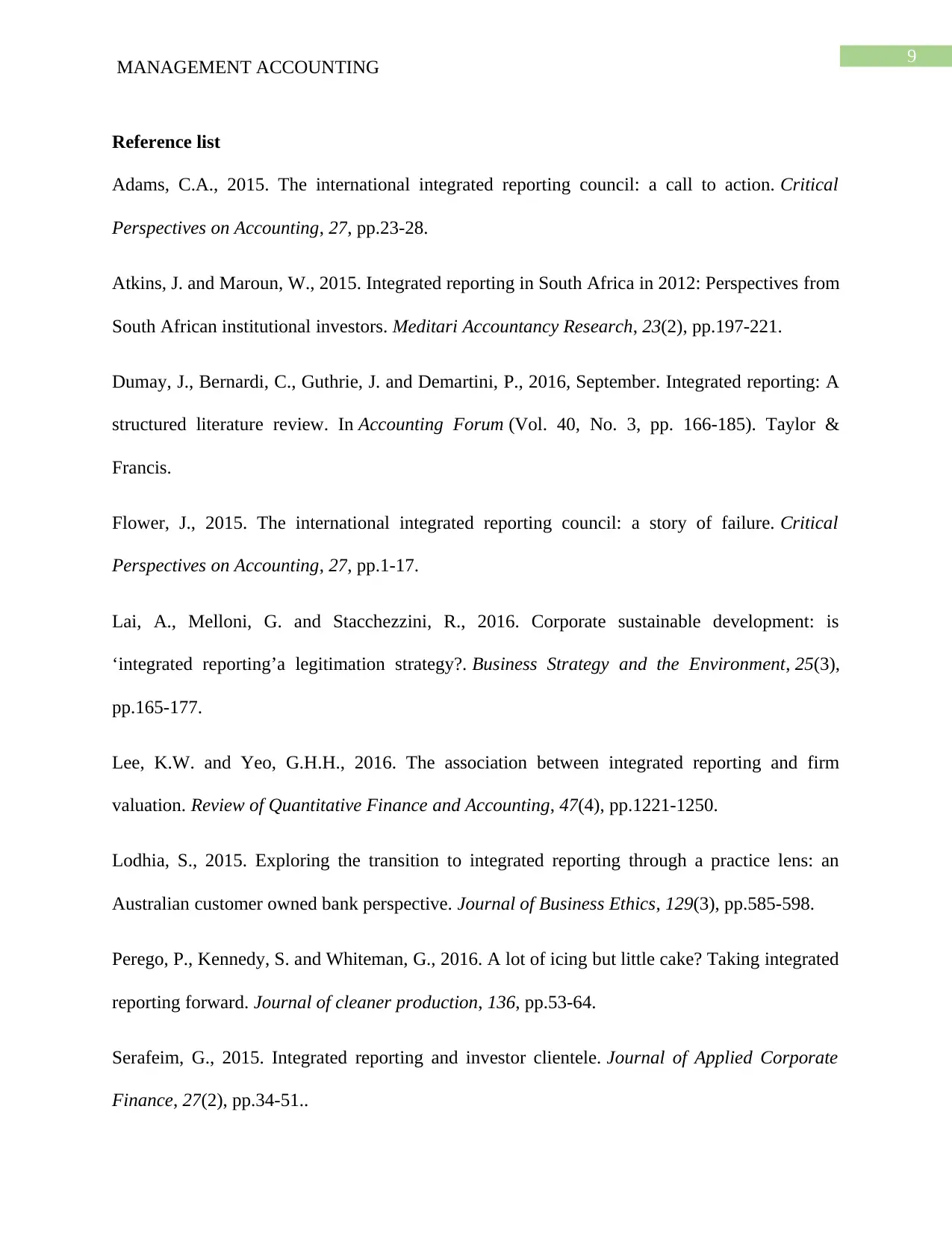
9
MANAGEMENT ACCOUNTING
Reference list
Adams, C.A., 2015. The international integrated reporting council: a call to action. Critical
Perspectives on Accounting, 27, pp.23-28.
Atkins, J. and Maroun, W., 2015. Integrated reporting in South Africa in 2012: Perspectives from
South African institutional investors. Meditari Accountancy Research, 23(2), pp.197-221.
Dumay, J., Bernardi, C., Guthrie, J. and Demartini, P., 2016, September. Integrated reporting: A
structured literature review. In Accounting Forum (Vol. 40, No. 3, pp. 166-185). Taylor &
Francis.
Flower, J., 2015. The international integrated reporting council: a story of failure. Critical
Perspectives on Accounting, 27, pp.1-17.
Lai, A., Melloni, G. and Stacchezzini, R., 2016. Corporate sustainable development: is
‘integrated reporting’a legitimation strategy?. Business Strategy and the Environment, 25(3),
pp.165-177.
Lee, K.W. and Yeo, G.H.H., 2016. The association between integrated reporting and firm
valuation. Review of Quantitative Finance and Accounting, 47(4), pp.1221-1250.
Lodhia, S., 2015. Exploring the transition to integrated reporting through a practice lens: an
Australian customer owned bank perspective. Journal of Business Ethics, 129(3), pp.585-598.
Perego, P., Kennedy, S. and Whiteman, G., 2016. A lot of icing but little cake? Taking integrated
reporting forward. Journal of cleaner production, 136, pp.53-64.
Serafeim, G., 2015. Integrated reporting and investor clientele. Journal of Applied Corporate
Finance, 27(2), pp.34-51..
MANAGEMENT ACCOUNTING
Reference list
Adams, C.A., 2015. The international integrated reporting council: a call to action. Critical
Perspectives on Accounting, 27, pp.23-28.
Atkins, J. and Maroun, W., 2015. Integrated reporting in South Africa in 2012: Perspectives from
South African institutional investors. Meditari Accountancy Research, 23(2), pp.197-221.
Dumay, J., Bernardi, C., Guthrie, J. and Demartini, P., 2016, September. Integrated reporting: A
structured literature review. In Accounting Forum (Vol. 40, No. 3, pp. 166-185). Taylor &
Francis.
Flower, J., 2015. The international integrated reporting council: a story of failure. Critical
Perspectives on Accounting, 27, pp.1-17.
Lai, A., Melloni, G. and Stacchezzini, R., 2016. Corporate sustainable development: is
‘integrated reporting’a legitimation strategy?. Business Strategy and the Environment, 25(3),
pp.165-177.
Lee, K.W. and Yeo, G.H.H., 2016. The association between integrated reporting and firm
valuation. Review of Quantitative Finance and Accounting, 47(4), pp.1221-1250.
Lodhia, S., 2015. Exploring the transition to integrated reporting through a practice lens: an
Australian customer owned bank perspective. Journal of Business Ethics, 129(3), pp.585-598.
Perego, P., Kennedy, S. and Whiteman, G., 2016. A lot of icing but little cake? Taking integrated
reporting forward. Journal of cleaner production, 136, pp.53-64.
Serafeim, G., 2015. Integrated reporting and investor clientele. Journal of Applied Corporate
Finance, 27(2), pp.34-51..
Paraphrase This Document
Need a fresh take? Get an instant paraphrase of this document with our AI Paraphraser
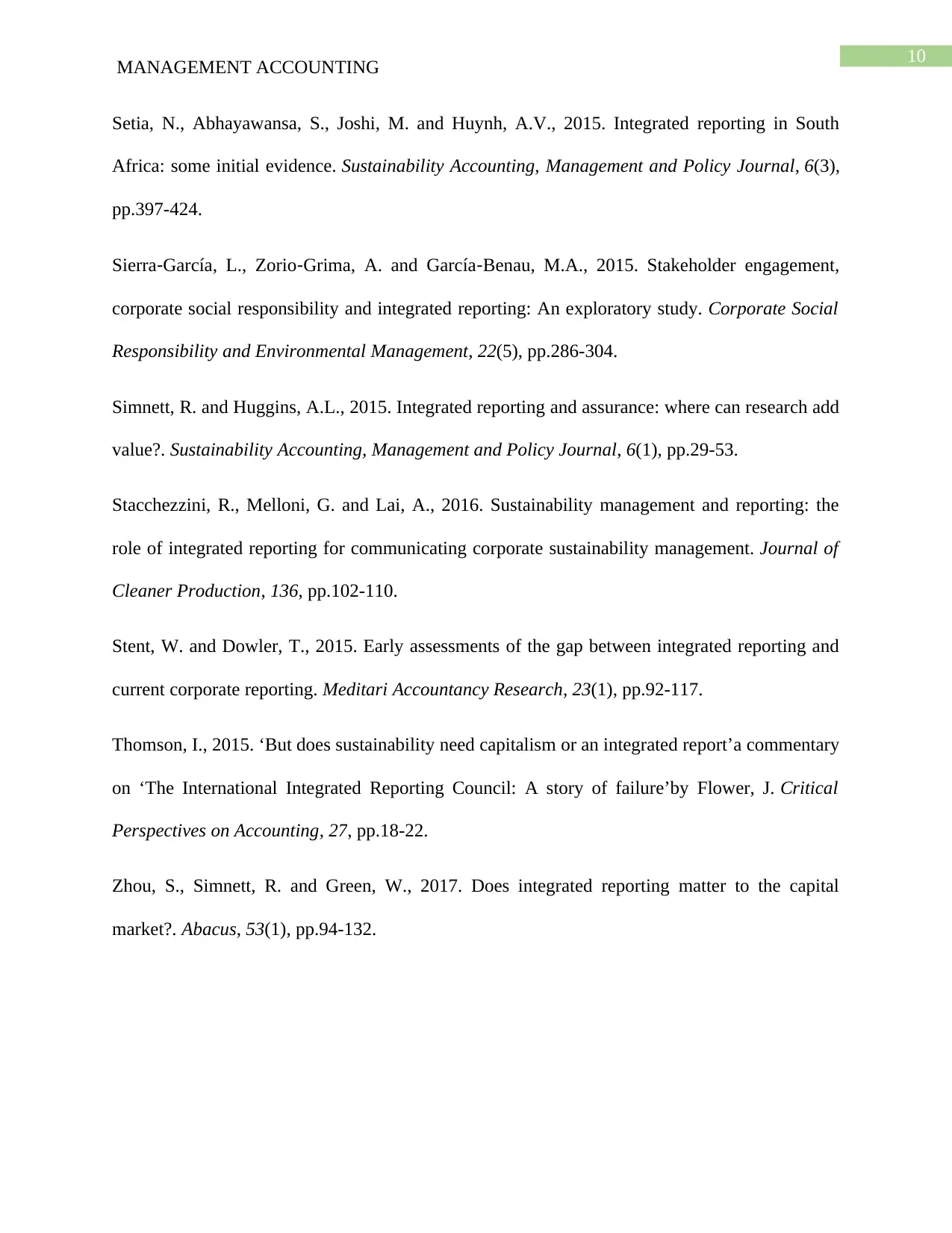
10
MANAGEMENT ACCOUNTING
Setia, N., Abhayawansa, S., Joshi, M. and Huynh, A.V., 2015. Integrated reporting in South
Africa: some initial evidence. Sustainability Accounting, Management and Policy Journal, 6(3),
pp.397-424.
Sierra‐García, L., Zorio‐Grima, A. and García‐Benau, M.A., 2015. Stakeholder engagement,
corporate social responsibility and integrated reporting: An exploratory study. Corporate Social
Responsibility and Environmental Management, 22(5), pp.286-304.
Simnett, R. and Huggins, A.L., 2015. Integrated reporting and assurance: where can research add
value?. Sustainability Accounting, Management and Policy Journal, 6(1), pp.29-53.
Stacchezzini, R., Melloni, G. and Lai, A., 2016. Sustainability management and reporting: the
role of integrated reporting for communicating corporate sustainability management. Journal of
Cleaner Production, 136, pp.102-110.
Stent, W. and Dowler, T., 2015. Early assessments of the gap between integrated reporting and
current corporate reporting. Meditari Accountancy Research, 23(1), pp.92-117.
Thomson, I., 2015. ‘But does sustainability need capitalism or an integrated report’a commentary
on ‘The International Integrated Reporting Council: A story of failure’by Flower, J. Critical
Perspectives on Accounting, 27, pp.18-22.
Zhou, S., Simnett, R. and Green, W., 2017. Does integrated reporting matter to the capital
market?. Abacus, 53(1), pp.94-132.
MANAGEMENT ACCOUNTING
Setia, N., Abhayawansa, S., Joshi, M. and Huynh, A.V., 2015. Integrated reporting in South
Africa: some initial evidence. Sustainability Accounting, Management and Policy Journal, 6(3),
pp.397-424.
Sierra‐García, L., Zorio‐Grima, A. and García‐Benau, M.A., 2015. Stakeholder engagement,
corporate social responsibility and integrated reporting: An exploratory study. Corporate Social
Responsibility and Environmental Management, 22(5), pp.286-304.
Simnett, R. and Huggins, A.L., 2015. Integrated reporting and assurance: where can research add
value?. Sustainability Accounting, Management and Policy Journal, 6(1), pp.29-53.
Stacchezzini, R., Melloni, G. and Lai, A., 2016. Sustainability management and reporting: the
role of integrated reporting for communicating corporate sustainability management. Journal of
Cleaner Production, 136, pp.102-110.
Stent, W. and Dowler, T., 2015. Early assessments of the gap between integrated reporting and
current corporate reporting. Meditari Accountancy Research, 23(1), pp.92-117.
Thomson, I., 2015. ‘But does sustainability need capitalism or an integrated report’a commentary
on ‘The International Integrated Reporting Council: A story of failure’by Flower, J. Critical
Perspectives on Accounting, 27, pp.18-22.
Zhou, S., Simnett, R. and Green, W., 2017. Does integrated reporting matter to the capital
market?. Abacus, 53(1), pp.94-132.
1 out of 11
Related Documents
Your All-in-One AI-Powered Toolkit for Academic Success.
+13062052269
info@desklib.com
Available 24*7 on WhatsApp / Email
![[object Object]](/_next/static/media/star-bottom.7253800d.svg)
Unlock your academic potential
Copyright © 2020–2025 A2Z Services. All Rights Reserved. Developed and managed by ZUCOL.




